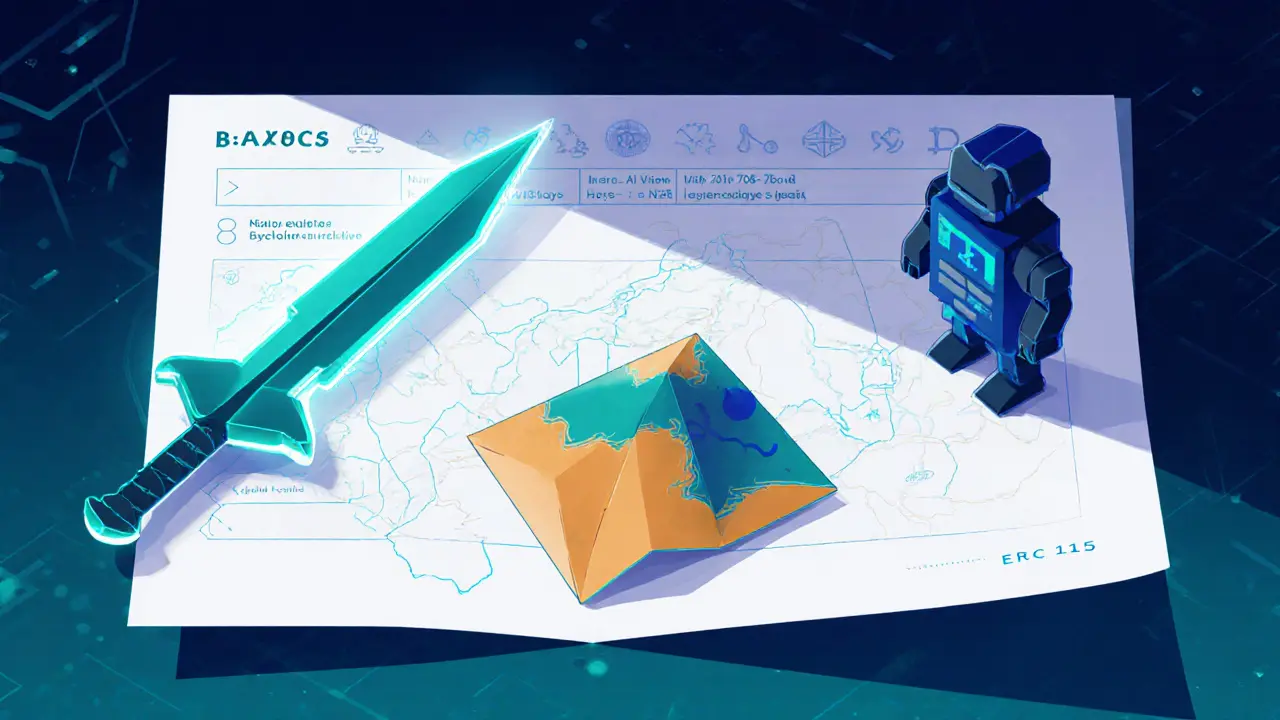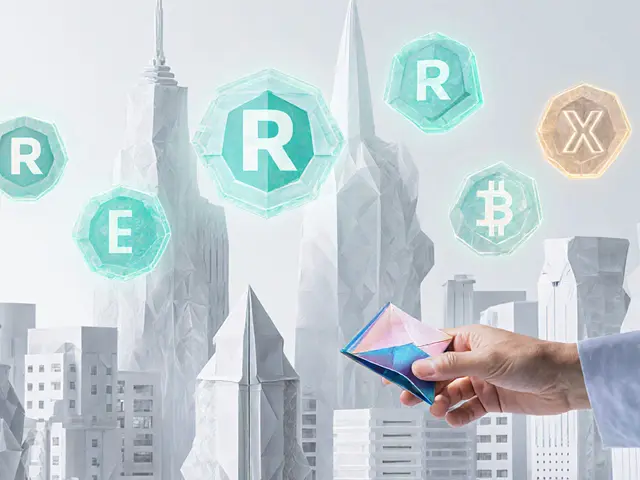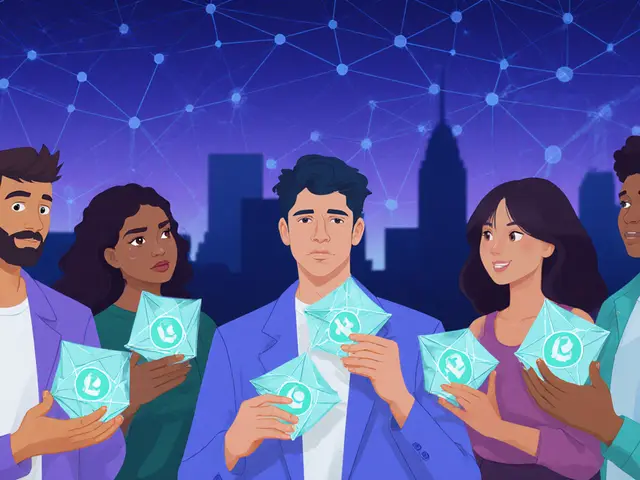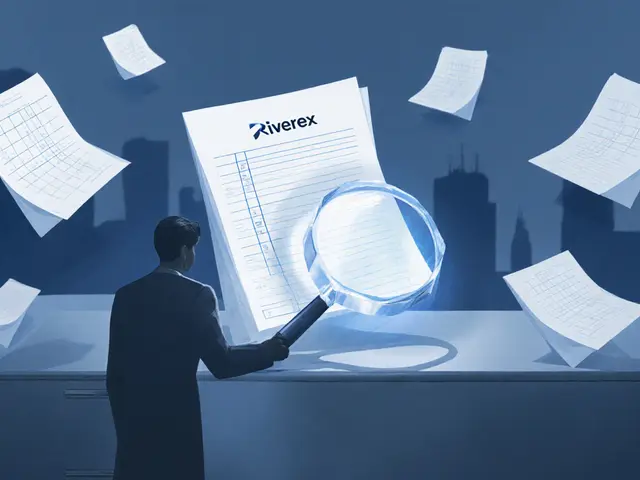NFT Explorer: Understanding Non-Fungible Tokens
What Are NFTs?
An NFT (Non-Fungible Token) is a unique digital asset stored on a blockchain. Unlike cryptocurrencies like Bitcoin or Ethereum, each NFT is distinct and cannot be exchanged on a one-to-one basis.
Key Features
- Blockchain Verification ✓
- Immutable Ownership ✓
- Smart Contract Royalties ✓
- Global Transferability ✓
- Interoperability ✓
NFT Market Overview (2025)
The NFT market has seen fluctuations since its peak in 2022 but continues to show strong growth potential.
How to Get Started
- Set up a crypto wallet (MetaMask, Trust Wallet)
- Buy some ETH to cover gas fees
- Choose a marketplace (OpenSea, LooksRare)
- Mint or purchase an NFT
- Enjoy your digital ownership!
When people talk about NFTs are unique digital tokens built on a blockchain that prove ownership of a specific item, they’re referring to a brand‑new way of owning anything that lives online.
Quick Take
- NFT = non‑fungible token, a one‑of‑a‑kind digital asset.
- Built on blockchains, most often Ethereum using the ERC‑721 or ERC‑1155 standards.
- Used for art, games, collectibles, virtual land, and emerging AI‑generated media.
- Market value bounced from $1.58billion in 2022 to roughly $600million in 2025, but long‑term forecasts still see multi‑billion growth.
- Buying or creating an NFT involves a crypto wallet, a marketplace, and paying a network “gas” fee.
What Exactly Are NFTs?
An NFT is a non‑fungible token that lives on a blockchain, making each token distinct and non‑interchangeable. Unlike Bitcoin or Ether, which are fungible - every unit is identical - an NFT has its own ID and metadata that defines what it represents. The metadata can point to an image, a video, a piece of music, or even a legal document.
How NFTs Work on the Blockchain
At the heart of every NFT is a blockchain a distributed ledger that records transactions in an immutable, public way. Most NFTs today live on Ethereum the pioneering smart‑contract platform that introduced the ERC‑721 token standard in 2018. When an NFT is minted, a smart contract writes a new entry to the ledger, assigning a unique token ID and linking it to off‑chain metadata.
The most common token standards are:
- ERC‑721: One‑to‑one mapping, each token is completely unique.
- ERC‑1155: Allows both fungible and non‑fungible items in a single contract, useful for gaming inventories.
Smart contracts also embed royalty rules, so creators can earn a percentage (often 2.5‑10%) every time the token changes hands.
Where Do NFTs Store Their Data?
The token itself only stores a hash or a URL. The actual content-image, video, or 3D model-usually lives on IPFS the InterPlanetary File System, a decentralized storage network that avoids a single point of failure. By separating ownership (on‑chain) from the asset (off‑chain), NFTs keep the proof of ownership secure while still allowing large files to be hosted efficiently.
Popular Use Cases in 2025
While digital art still grabs headlines, the ecosystem has broadened dramatically.
- Digital Art: Artists mint unique pieces and collect ongoing royalties. Platforms like OpenSea and Art Blocks dominate this space.
- Gaming NFTs: In‑game items, skins, and virtual land can be transferred across titles, giving players real ownership of their digital loot.
- Utility NFTs (NFT2.0): Access passes to exclusive events, membership clubs, or even fractional ownership of physical assets such as real‑estate.
- Fashion & Collectibles: Brands issue digital wearables verified on‑chain, while sports leagues sell interactive trading cards.
- AI‑Generated NFTs: Algorithms create unique visuals or music and instantly mint them, blurring the line between creator and code.

Market Snapshot for 2025
Revenue peaked at $1.58billion in 2022, slid to about $600‑$700million after the correction, and is now hovering near $650million. Different research firms still disagree on the total market size-CoinLedger reports $43billion in 2024 and projects $61billion in 2025, while Precedence Research caps 2025 at $48billion. Regardless of the numbers, the sector is expected to keep growing as utility‑driven projects gain traction.
Benefits Over Traditional Digital Assets
| Feature | NFTs | Traditional Digital Files |
|---|---|---|
| Ownership Proof | Blockchain‑verified, immutable | Usually a copy with no verifiable claim |
| Transferability | Instant, global, no intermediaries | Often restricted by platform licenses |
| Royalties | Auto‑executed via smart contracts | Manual, if any |
| Interoperability | Can move across compatible marketplaces | Locked to original host or app |
The table highlights why many creators favor NFTs: they can prove scarcity, earn passive income, and let anyone around the world buy or sell with just a few clicks.
Drawbacks and Risks
Every upside has a flip side.
- Environmental Impact: Proof‑of‑work blockchains (like early Ethereum) consume huge amounts of electricity. The shift to proof‑of‑stake mitigates this, but legacy NFTs still carry the carbon footprint.
- Price Volatility: Tokens can swing wildly; a $10,000 artwork might be worth $500 a month later.
- Legal Ambiguity: Owning an NFT doesn’t automatically grant copyright or reproduction rights. Jurisdictions differ on tax treatment.
- Technical Barriers: New users must manage wallets, private keys, and gas fees-an intimidating learning curve.
Step‑by‑Step: Creating and Buying Your First NFT
- Set Up a Crypto Wallet: Download MetaMask, Trust Wallet, or any ERC‑20 compatible wallet. Secure the seed phrase.
- Buy Some Ether (ETH): Transfer fiat via an exchange (e.g., Coinbase) and move ETH to your wallet. You’ll need this for gas fees.
- Choose a Marketplace: For beginners, OpenSea or LooksRare offer user‑friendly interfaces.
- Mint Your Token: Upload the file, fill in metadata (title, description, royalty %), and confirm the transaction. The smart contract will create a unique token ID.
- List or Purchase: Set a fixed price or start an auction. When a buyer clicks “Buy”, the contract transfers ownership and updates the ledger automatically.
Typical minting takes 2‑4hours for a first‑time creator, while buying a listed NFT is usually done in minutes.
Future Trends: AI, Interoperability, and the Metaverse
AI is reshaping the creation pipeline. Platforms like Art Blocks let algorithms generate on‑chain art that changes with each mint. Alethea AI adds conversational avatars that learn from user interaction, opening doors to dynamic NFTs that evolve over time.
Interoperability protocols (e.g., Polygon bridge, Immutable X) are lowering gas costs and enabling cross‑chain swaps, so an NFT bought on Ethereum could later appear on a sidechain without losing provenance.
Virtual reality and the metaverse are the next frontier. Imagine walking through a 3D gallery where each displayed piece is an NFT you can purchase with a click, or owning a virtual plot of land that grants you advertising rights in a VR world. As browsers and headsets become mainstream, NFTs are poised to become the building blocks of digital property rights.
Frequently Asked Questions
What does "non‑fungible" actually mean?
Non‑fungible means each token is unique and can’t be swapped on a one‑to‑one basis like regular coins or dollars. One NFT might represent a specific artwork, while another represents a completely different asset.
Do I need to be a programmer to create an NFT?
No. Most marketplaces provide a “mint” button that handles the smart‑contract code behind the scenes. Advanced creators who want custom royalty logic may need to write Solidity, but it’s optional for basic NFTs.
Are NFTs a good investment?
It depends. Some NFTs have appreciated dramatically, while many have lost value after the 2022 boom. Treat them like any speculative asset: only invest money you can afford to lose and consider the utility or cultural significance of the piece.
What taxes apply to NFT sales?
In the United States, NFTs are treated as property, so capital‑gains tax rules apply. Europe is still forming guidance, but many jurisdictions require reporting of crypto‑related gains. Always check local regulations or consult a tax professional.
Can I sell an NFT I bought on a different marketplace?
Yes. Ownership is recorded on the blockchain, not on any single platform. As long as the new marketplace supports the same token standard (e.g., ERC‑721), you can transfer or list the NFT anywhere.





Marie Salcedo
Great overview! I love how the guide breaks down each step for beginners.
Noel Lees
Honestly, the NFT hype is overblown 🙄. If you’re not making money, you’re just a collector.
Raphael Tomasetti
ERC‑721 vs ERC‑1155: the former is pure uniqueness, the latter adds batch efficiency for gaming assets.
Jenny Simpson
Oh, please! Nobody needs another "future of art" sermon. The market will implode when the novelty wears off.
Sabrina Qureshi
Wow!!! This article is soooo thorough!!! I mean, who even needs a PhD to understand NFTs?!?!?!
Janelle Hansford
Hey there! If you’re feeling overwhelmed, start small – maybe mint a single meme piece and see how the process feels.
dennis shiner
Sure, NFTs are "revolutionary"-if your idea of revolution is paying gas fees for a JPEG.
Maggie Ruland
Right, because nothing says "innovation" like a digital receipt for bragging rights.
Joyce Welu Johnson
Reading through this, I can’t help but feel a mix of awe and anxiety. The technology itself is undeniably fascinating, offering a new way to prove ownership in a digital world. Yet, each step-setting up a wallet, buying Ether, paying gas-adds layers of complexity that can deter newcomers. The promise of perpetual royalties is a dream for creators, but only if marketplaces enforce them fairly. Meanwhile, the environmental concerns linger, even if proof‑of‑stake mitigates some impact. It’s also crucial to remember that owning an NFT doesn’t grant you the underlying copyright, a nuance many overlook. Market volatility is another beast; yesterday’s $10k piece can become $100 tomorrow. Despite these challenges, the community continues to innovate, especially with AI‑generated art that blurs creator boundaries. Interoperability across chains is improving, thanks to bridges, making assets more fluid. The shift toward utility NFTs-like access passes and fractional ownership-shows the space maturing beyond pure speculation. For beginners, the most important advice is to start small, experiment, and treat each purchase as a learning experience. Secure your seed phrase; losing it means losing everything. Stay curious, ask questions, and don’t be afraid to walk away from hype. In the end, NFTs could become the digital equivalent of property deeds, but only if we build robust standards and consumer protections. Keep an eye on emerging regulations, as they will shape the future landscape. And remember: the best investment is knowledge-understand the tech, the markets, and your own risk tolerance.
Ally Woods
Meh, I’ll pass.
Kristen Rws
Thsi is a fairly claar explenation, hope it helps new folowers!
Fionnbharr Davies
From a philosophical standpoint, NFTs invite us to reconsider what ownership means in a borderless digital realm, blurring the line between tangible and intangible value.
Narender Kumar
Honoured to witness the burgeoning epoch of non‑fungible tokens; their significance shall echo through the annals of digital civilization.
Anurag Sinha
What they won’t tell you is that the entire NFT infrastructure is a front for a massive data‑harvesting operation orchestrated by unseen powers.
Raj Dixit
Investing in NFTs without moral scrutiny is tantamount to endorsing a culture of excess and environmental neglect.
Darrin Budzak
Take it easy-start with a low‑cost mint just to get the feel of the wallet and gas fees.
Andrew McDonald
While the layperson scrambles for entry‑level NFTs, true connoisseurs appreciate the nuanced curation that only elite platforms can provide.
Enya Van der most
Let’s get pumped! If you dive into NFTs now, you’re surfing the next wave of digital creativity-ride it hard!
Eugene Myazin
Hey folks, just a heads‑up: the biggest growth is happening in utility NFTs-think membership passes and real‑world asset tokenization.
karyn brown
Honestly, most of this is just hype 🙈. If you’re not seeing real value, stay away! 🚫